Abstract
In order to solve the problem of strong downward clutter jamming in airborne radar detection, we propose a phase-only transmit beampattern synthesis method. Firstly, with the aim of minimizing the sidelobe gain in the cluttered region, the desired radiation pattern is constructed by using terrain environmental information from where the airborne radar operates. Secondly, an optimization model for phase-only transmit beampattern synthesis accounting for four constraints (the mainlobe gain, the sidelobe gain in the highly cluttered region, the sidelobe gain at other angles, and the amplitude of the weight vector) is established. The Alternating Direction Method of Multipliers (ADMM) is then used to find the iterative solution. Based on the results of four sets of simulation examples designed to verify the effectiveness of the proposed method, it is concluded that the method can reduce the echo intensity in the cluttered region and is suitable for a wide range of array configurations.
1. Introduction
Airborne radar is operated from high-flying aircraft to overcome the limitation of ground radar’s line of sight due to the curvature of the Earth. It can be rapidly and flexibly deployed to required locations and used to evade attacks; however, there are also significant challenges. Due to radar operating in either horizontal or downward viewing mode, it is affected by broadly distributed, dense clutter. This is particularly evident in mountainous and hilly areas, where the clutter intensity can reach 50–60 dB, posing a significant challenge to achieving a satisfactory radar target detection performance. Achieving low sidelobes and reducing the strength of clutter echoes by implementing transmit beampattern synthesis for airborne radar is one effective means of addressing these issues []. Generally speaking, improvement in radar target detection performance through beampattern synthesis is contingent upon various factors, including the operational environment, the type of radar employed, and the characteristics of the targets to be detected. The requirements for sidelobe levels and beam shapes vary across different operational scenarios. Additionally, practical engineering constraints, such as radar size, beam directionality, and beamwidth, typically necessitate the implementation of low sidelobe beampatterns of −10 to −30 dB for airborne radar systems.
The radar beampattern synthesis method involves finding a weight vector for the antenna array in order to produce a specified radiation pattern [,,,,,,,,,,]. Beampattern synthesis is mainly achieved using three different methods: (i) amplitude-only weighting, (ii) phase-only weighting, and (iii) phase–amplitude weighting []. Commonly used methods typically aim to obtain the ideal beam shape based on simultaneous phase–amplitude weighting. However, due to the limited array aperture of airborne radar and the fact that the power amplifiers in phased arrays operate in the saturation region to provide peak power output, it is challenging to achieve dynamic amplitude control during transmission. Therefore, in this case, phase-only weighting becomes the preferred technique for transmitted beampattern synthesis.
There are many works available in the literature on the synthesis of wide beams using phase-only spoiling [,,,,,,,,,]. Traditional methods include Chebyshev synthesis, Taylor synthesis, Fourier transformation, and the Woodward–Lawson method. In [], it was shown that the phase-only technique results in better power efficiency than the two other methods, while the amplitude-only technique results in a better beam shape. In [], the authors used the ADMM to achieve constant Modulus Pattern Synthesis for flat-top beams. In [], the authors use a quasi-Newton method to achieve beamforming with phase-only weighting. In [], a homotopy-based Stochastic Gradient Descent method for finding the optimal phase disruption vector was proposed and was shown to have excellent performance but at the cost of higher sidelobe levels. In [], the authors introduced an evolutionary approach named Social Network Optimization (SNO), which was applied to the design of a reduced-size shaped beam reflectarray. In [], the authors presented a new optimization algorithm based on the behavior of fungi kingdom expansion (FKE) to optimize the radiation pattern of array antennas.
However, these methods do not specifically address clutter suppression issues during airborne radar detection. In this study, we focused on airborne radar transmit beampattern synthesis based on clutter-related environmental information, according to which different expected radiation patterns were constructed to enhance radar adaptability in various environments. With the proposed method, on one hand, a minimal ratio between the sidelobe level in the cluttered region and the mainlobe level can be achieved, which means that the sidelobe level in the cluttered area is sufficiently low, which improves the radar’s clutter suppression capability. On the other hand, by constraining the mainlobe gain of the airborne radar and the sidelobe level in non-cluttered areas and by applying phase weighting to the array excitation, an excitation weight vector that is strictly consistent in amplitude can be derived, avoiding unsaturated output from the airborne radar’s feed network, which could compromise radar detection performance.
The contributions of our study are as follows:
- (1)
- We constructed the desired beampattern shape for the downward cluttered area based on clutter information from the airborne radar’s operating environment, enhancing the adaptability of this technology to different operational environments.
- (2)
- To minimize echo strength in the cluttered area as much as possible while satisfying the array gain with phase-only weighting, we established a mathematical model aimed at minimizing the expected sidelobe level in the ground cluttered area. This involved constraining the mainlobe gain of the array, the sidelobe level at scanning angles outside the ground cluttered area, and array excitation with phase-only weighting. The aim was to minimize the sidelobe levels under the constraint of achieving the desired beampattern shape while retaining the detection performance of the mainlobe.
- (3)
- We introduced auxiliary variables to simplify the optimization model and employed the ADMM to decompose it into multiple subproblems, which were solved iteratively to perform phase-only weighting for beampattern synthesis.
In this study, vectors and matrices are denoted by boldface lowercase and uppercase letters, respectively. , , and are the transpose, conjugate transpose, and conjugate, respectively. and represent the zero and one matrices, respectively. and are the real and imaginary parts, respectively, with , and and are also the real and imaginary parts of elements in an array, respectively. is the magnitude of a complex-valued scalar.
2. Beampattern and Clutter Model
2.1. Array Beampattern
We consider a linear array with N antenna elements; its far-field radiation beampattern in the direction can be expressed as
where denotes the complex excitation vector and denotes the steering vector. The definition of each component in is as follows:
where is the element location, with , and is the wavelength.
For a 2D meta planar array with antenna elements, we can use the 2D steering vector to replace the 1D steering vector in the above equation. The definition of each component is
where is the element location.
2.2. Clutter Model
For radar using a pulse compression system, its distance resolution is
where is the speed of electromagnetic waves, and is the working bandwidth.
The projection of the oblique distance unit on the ground is the smallest partition unit of the ground distance loop.
where is the grazing angle.
The azimuth width of clutter cells is generally related to the radar’s Doppler resolution. Since, in this study, we only consider suppressing ground clutter with spatial beampattern synthesis, the Doppler characteristics of the clutter cells do not affect the shape of the transmitted beam. Therefore, we use a constant, , to express the number of directional cells in each distance loop; then, the radians of each cell’s orientation are , and the area of each clutter cell is
where is the distance between a clutter cell and the radar. According to the radar equation, the echo power of each clutter cell is
where is the radar transmission power, is the transmission gain, is the reception gain, and is the backscattering coefficient of the clutter cell.
3. Proposed Method
3.1. Desired Beampattern
According to the radar equation, the echo power () is a function related to the transmission gain. By changing the transmission gain of the antenna, the received echo power () of the radar can be made to approach a constant, , using
The expected directional diagram of the highly cluttered area is constructed as follows:
where k is a constant.
3.2. Optimization Model
In this section, we show how we constructed a phase-only transmit beampattern synthesis optimization model that minimizes the sidelobe gain in the cluttered region.
We divide the array scanning angles () into three categories: the mainlobe beam direction (); the set of sidelobe scanning angles in the highly cluttered area (), with being the number of scanning angles in the highly cluttered area; and the set of other sidelobe scanning angles (), with being the number of other sidelobe scanning angles. For airborne radar, we generally consider the scanning angle of the radar towards the ground to be the scanning angle of the highly cluttered area. Except for the mainlobe direction and the scanning angle facing the ground, the angles are collectively referred to as other sidelobe scanning angles.
We expect the mainlobe level to be as high as possible and the sidelobe level in areas with strong ground clutter to be as low as possible. At the same time, in order to maintain the detection performance of the radar’s mainlobe, certain constraints are imposed on the sidelobe level in other cluttered areas. The following optimization model can then be written:
where , ; , ; and is the upper limit of the sidelobe level in other cluttered areas.
3.3. Solution
Due to the coupling of independent variables in both the numerator and denominator of the objective function, it is difficult to perform direct operations. We introduce auxiliary variables and :
where is the upper limit of the highly cluttered region level constraint and is the lower limit of the mainlobe level.
Considering that the beam in the highly cluttered area tends towards the desired beampattern, the latter is fitted and interpolated. is the normalized desired beampattern at the scanning angle to obtain the normalized expected beampattern level at scanning angle . The second constraint in Equation (11) can be written as
Since is a phase-only weight vector, the fourth constraint in Equation (11) can be written as
We introduce the following auxiliary variables to simplify the objective function: , , and , where and represent the absolute sidelobe gains of the beampattern, and and represent the relative sidelobe levels of the directional patterns (measured in dB). Equation (11) can be written as
To simplify the constraints, we introduce auxiliary variables and , where , , and . We construct an augmented Lagrangian function with constraints as follows:
where , , and are Lagrange multipliers corresponding to the constraints, and is the user-defined step size.
Based on the ADMM, we solve Equation (15) via the following iterative steps.
Firstly, we update with , obtained in the t-th iteration, by solving the optimization problem. The following processes solve for , and , respectively.
We introduce auxiliary variables and ignore irrelevant items, and the solution of is
The subproblem of is difficult to solve because and are coupled together. Based on [], we introduce auxiliary variables and step functions ; the subproblem can be written as
Based on the different values of , we divide the feasible value range of , , into regions and solve the problem in Equation (17) in segments. For subregion of the value of , the optimal solution is
is the optimal solution for all results. The result of is
We introduce auxiliary variables . The solution of is
Secondly, we update with the given and ignore irrelevant items. The optimization problem related to can be written as
where is always greater than 0.
If is given, when reaches its minimum value,
By using the BFGS method for finding the iterative solution, we obtain the optimal solution, . The solution of is
Finally, we update .
The updated formula is
Based on the above steps, the proposed beampattern synthesis solution method based on the ADMM and the BFGS method is summarized in Algorithm 1.
| Algorithm 1 The solution method using the ADMM and the BFGS method |
| Begin Initialization: do{ Obtain using Equations (16), (19) and (20); Obtain using Equation (23); Obtain using Equation (24); ; }while{} Output: End |
The proposed beampattern synthesis method is summarized in Figure 1.
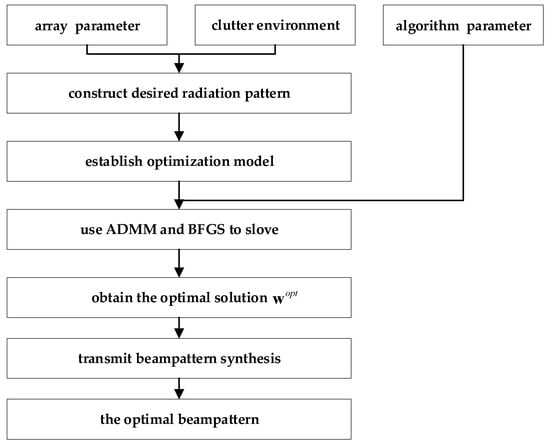
Figure 1.
The program flow of the proposed beampattern synthesis method.
3.4. Convergence
The proposed method is based on the ADMM and the BFGS method, where the former has a superior convergence property (see [,] for details) and the latter has the Q-linear convergence property (see Appendix C for details). Therefore, the proposed method converges.
3.5. Computational Complexity
To calculate the computational complexity, we consider the most significant component, namely, the multiplications involved in one iteration. Updating and requires , and updating requires . Therefore, the proposed method requires in one iteration.
Due to the use of the ADMM and BFGS algorithms for the implementation of the iterative solving process, the latter is impacted by the convergence speed of the ADMM and the computational complexity of BFGS for high-dimensional calculations. As a result, this method is primarily suited for small-scale array beampattern synthesis, and convergence issues may arise when it is applied to large-scale and ultra-large-scale arrays.
4. Simulation Results
In this section, we present four sets of numerical examples to evaluate the performance of the proposed method. We set the aircraft altitude to 8000 m and considered clutter echoes within a radius of 20 km. In the first two examples, we used a 16-element half-wavelength linear array to verify beampattern synthesis performance under ground and sea conditions. In the last two examples, we used a 5 × 5-element planar array and a conformal array to complete beampattern synthesis, respectively.
The input parameters for the first two simulation examples are shown in Table 1.

Table 1.
Input parameter table.
In the last two simulation examples, we set the to (0,0), is the region of , is the region of and , and the iteration count T is set to 1000.
We used the modified Morchin model to simulate ground and sea clutter. In Examples 1, 3, and 4, we used a ground clutter model under hilly terrain conditions, while in Example 2, we used a sea clutter model under sea conditions. Figure 2 shows the relationship between clutter echo power and simulated with the Morchin model.
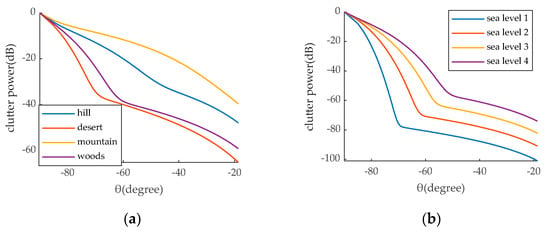
Figure 2.
The relationship between clutter echo power and simulated by using the Morchin model: (a) ground clutter; (b) sea clutter.
4.1. Hilly Terrain
In the first example, we analyzed the clutter echo power in airborne radar detection under hilly terrain conditions and synthesized the desired beampattern to suppress ground clutter. For ease of display, we define , , and as the errors between the auxiliary variables and the angular responses (AVARs) in all the iterations. Figure 3a shows the evolution curve of , , and . Figure 3b shows the amplitude- and phase-weighted results of the directional diagram. Figure 3c shows the beampattern synthesis results in a cluttered environment with a hilly terrain and their comparison with the results obtained with the methods of “Array Beampattern Synthesis Without Specifying Lobe Level Masks (WLLM)” in [], genetic algorithm (GA), and standard beampattern. Figure 3d shows the unnormalized beampattern synthesis results. Figure 3e shows a comparison of echo signal power among the proposed algorithm’s beampattern, the original beampattern, and the gain-free beampattern. From these figures, it can be seen that the proposed method and WLLM performed well in beampattern synthesis. The beampattern of the proposed method can obtain a sidelobe level, (), of −18.73 dB and a mainlobe direction offset, (), of −2 degrees. WLLM can obtain a sidelobe level, (), of −33.49 dB and no deviation in the direction of the mainlobe. However, WLLM introduced some amplitude errors. The GA produced poor results and did not achieve the desired beampattern.
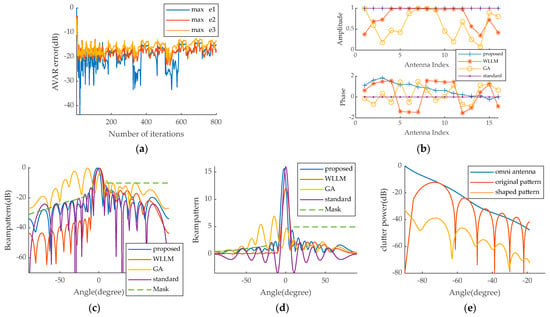
Figure 3.
Simulation results of Example 1: (a) evolution curve; (b) amplitude- and phase-weighted results; (c) beampattern synthesis results; (d) unnormalized beampattern synthesis results; (e) echo signal power.
4.2. Sea Conditions
In the second example, we analyzed the clutter echo intensity in airborne radar detection in sea conditions and synthesized the desired beampattern to suppress sea clutter. Figure 4 shows the evolution curve, the amplitude and phase weight results, the beampattern synthesis results, the unnormalized beampattern synthesis results, and the echo signal power in sea mode. It can be seen that the proposed algorithm can also provide good results regarding the sidelobe shape in the cluttered sea area. The beampattern of the proposed method can obtain a sidelobe level, (), of −16.08 dB and a mainlobe direction offset, (), of 2 degrees. WLLM can obtain a sidelobe level, (), of −30.75 dB and no deviation in the direction of the mainlobe. Although the sidelobe level is slightly higher than that obtained with WLLM, the proposed algorithm can maintain strict amplitude consistency, which is not achievable with WLLM and the GA. In addition, we calculated the AVAR error in each iteration, and it can be seen that the error decreases with an increase in iteration time. Figure 4e shows that this algorithm can achieve a good clutter suppression effect.
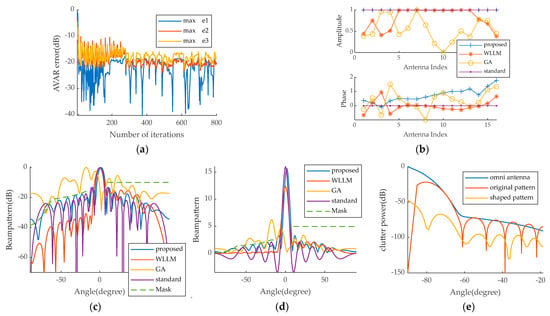
Figure 4.
Simulation results of Example 2: (a) evolution curve; (b) amplitude- and phase-weighted results; (c) beampattern synthesis results; (d) unnormalized beampattern synthesis results; (e) echo signal power.
4.3. Planar Array
In the third example, we investigated the use of a planar array under hilly terrain conditions. Figure 5a–l show the array position, the evolution curve, the amplitude- and phase-weighted results, the beampattern synthesis results, the unnormalized beampattern synthesis results, 3D representations of the beampattern synthesis results, and the echo power under hilly terrain conditions, respectively. In Figure 5a, we show the results obtained by using a 5 × 5 planar array antenna for simulation. As shown in Figure 5b, the AVAR error of the planar array quickly decreases and then maintains a small level of error variation. The amplitude constraint of the algorithm shown in Figure 5c is also satisfied. In Figure 5d–i, we can see that the proposed algorithm can also meet the shape requirements in the case of a planar array. The beam pattern of the proposed method can obtain a sidelobe level, (), of −13.48 dB and a mainlobe direction offset, (), of 5 degrees. Based on the color analysis of echo intensity in the color-bar comparison (Figure 5j–l), we can see that the proposed algorithm can achieve the suppression of planar array clutter echoes greater than 80 dB.
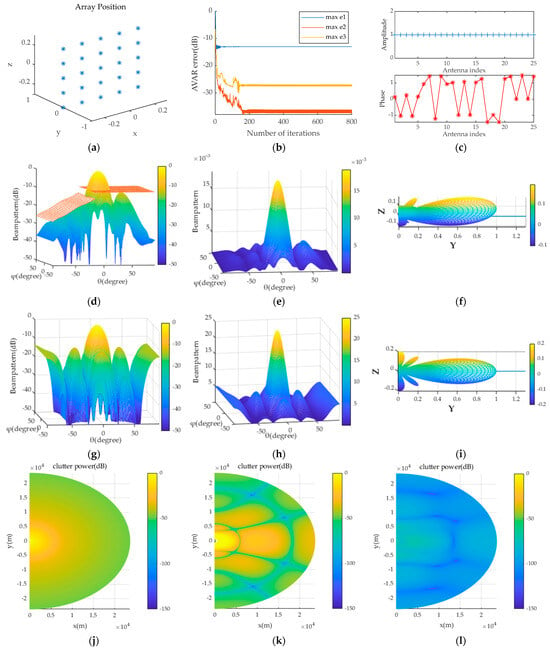
Figure 5.
Simulation results of Example 3: (a) array position; (b) evolution curve; (c) amplitude- and phase-weighted results; (d) beampattern synthesis results; (e) unnormalized beampattern synthesis results; (f) 3D representations of synthesized beampattern; (g) standard beampattern; (h) unnormalized standard beampattern; (i) 3D representations of standard beampattern; (j) echo signal power of gain-free beampattern; (k) echo signal power of original beampattern; (l) echo signal power of proposed algorithm.
4.4. Conformal Array
In the fourth example, we investigated the use of a conformal array under hilly terrain conditions. Figure 6a–j show the array position, the evolution curve, the amplitude- and phase-weighted results, the beampattern synthesis results, the unnormalized beampattern synthesis results, 3D representations of the beampattern synthesis results, and the echo power under hilly terrain conditions, respectively. In Figure 6a, we show the results obtained by using cylindrical conformal antennas for simulation. As shown in Figure 6b, the AVAR error of the conformal array quickly decreases. The amplitude constraint of the algorithm shown in Figure 6c is also satisfied. In Figure 6d–i, we can see that the proposed method with a conformal array produces good beampattern synthesis results in highly cluttered areas, but the sidelobe level slightly increases at other sidelobe scanning angles. The beampattern of the proposed method can obtain a sidelobe level, (), of −13.04 dB and a mainlobe direction offset, (), of 3.6 degrees. By comparing Figure 6j–l, we can see that the proposed algorithm can suppress planar array clutter echoes greater than 60 dB.

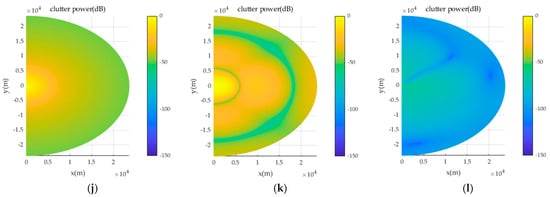
Figure 6.
Simulation results of Example 4: (a) array position; (b) evolution curve; (c) amplitude- and phase-weighted results; (d) beampattern synthesis results; (e) unnormalized beampattern synthesis results; (f) 3D representations of synthesized beampattern; (g) standard beampattern; (h) unnormalized standard beampattern; (i) 3D representations of standard beampattern; (j) echo signal power of gain-free beampattern; (k) echo signal power of original beampattern; (l) echo signal power of proposed algorithm.
4.5. Monte Carlo Simulations
We conducted 500 Monte Carlo simulations for the four examples and calculated the average values of the sidelobe level in highly cluttered areas (), the sidelobe gains in highly cluttered areas (), the maximum sidelobe level at other sidelobe scanning angles (), the mainlobe direction offset (), the mainlobe gain (), and the running time () on our PC (Intel i7-13700 CPU, 64 bit, and 64 GB RAM) based on the simulation results. It can be seen in Table 2 that the method developed in this study has good robustness, and the results obtained can be achieved with low sidelobes.

Table 2.
Performance comparison of Monte Carlo results for different simulations using the proposed method.
5. Conclusions
In this study, we developed a new transmission beampattern synthesis method based solely on phase weighting for airborne radar. The proposed transmission beampattern is constructed based on clutter information, and a good clutter suppression effect is achieved by minimizing the expected sidelobe level in the ground cluttered area. In four sets of examples, the method developed in this study showed good effectiveness and robustness; it has certain advantages over other methods in terms of beampattern synthesis and phase-only weighting.
Author Contributions
Conceptualization, J.S. and J.Z.; software, J.S.; validation, J.S., J.Z., L.L. and C.Z.; writing—original draft preparation, J.S.; writing—review and editing, J.S. All authors have read and agreed to the published version of the manuscript.
Funding
This research study was funded by National Natural Science Foundation of China, grant number No. 62171350.
Institutional Review Board Statement
Not applicable.
Informed Consent Statement
Not applicable.
Data Availability Statement
Data are contained within the article.
Acknowledgments
We declare that we have no financial and personal relationships with other people or organizations that can inappropriately influence our work; there is no professional or otherwise personal interest of any nature or kind in any product, service, and/or company that could be construed as influencing the position presented in or the review of the present manuscript.
Conflicts of Interest
Author Lichu Lai was employed by Xi’an Shengxin Technology Co., Ltd. The remaining authors declare that the research was conducted in the absence of any commercial or financial relationships that could be construed as a potential conflict of interest.
Appendix A. Morchin Model
Appendix A.1. Ground Clutter Model
The ground clutter Morchin model is
where is the grazing angle; when a < b under desert terrain conditions, , , , and . f is the operating frequency of the radar, measured in GHz. The values of the other parameters are shown in Table A1.

Table A1.
Parameter table.
Table A1.
Parameter table.
| Landform Type | A | B | ||
|---|---|---|---|---|
| Desert | 0.00126 | 0.14 | ||
| Hill | 0.0126 | 0.40 | 1 | |
| Mountain | 0.0400 | 1.24 | 0.50 | 1 |
| Woods | 0.00916 | 0.32 | 1 |
Appendix A.2. Sea Clutter Model
The sea clutter Morchin model is
where ss is the sea level, with values ranging from 0 to 6, while the value range of k is 1–4. . The other parameter values are
Appendix B. ADMM
The ADMM is applicable to problems which can be formulated as the following constrained optimization:
The augmented Lagrangian function constructed from (A4) is
where and are the step size and the Lagrange multiplier vector, respectively. The ADMM can be used to solve (A4) via the decomposition-coordinated procedure, and the resultant iterative updating steps are
Appendix C. BFGS
Appendix C.1. Introduction to BFGS
The quasi-Newtonian condition is
In the above, .
The BFGS algorithm uses to approximate the Hessian matrix (), and the iteration format is as follows:
The iterative update formula for is as follows:
Appendix C.2. Convergence of BFGS
We assume that the initial matrix, , is a symmetric positive definite matrix, the objective function is a twice continuously differentiable function, and the lower-level set
is a convex function. Furthermore, there exists a constant , , such that , with , satisfies
Then, the BFGS quasi-Newton method can globally converge to minimize of .
References
- Liang, J.; Fan, X.; So, H.C.; Zhou, D. Array Beampattern Synthesis Without Specifying Lobe Level Masks. IEEE Trans. Antennas Propag. 2020, 68, 4526–4539. [Google Scholar] [CrossRef]
- Wang, F.; Balakrishnan, V.; Zhou, P.Y.; Chen, J.; Yang, R.; Frank, C. Optimal array pattern synthesis using semidefinite programming. In Proceedings of the 2001 IEEE International Conference on Acoustics, Speech, and Signal Processing Proceedings (Cat No01CH37221), Salt Lake City, UT, USA, 7–11 May 2001. [Google Scholar]
- Zhang, A.; Lei, S.; Yang, W.; Tian, J.; Hu, H.; Xiao, L. Mainlobe/Sidelobe Region Gap Minimization for Shaped-Beam Pattern Synthesis via Antenna Array. IEEE Antennas Wirel. Propag. Lett. 2024, 23, 144–148. [Google Scholar] [CrossRef]
- Zhan, S.; Zhenghe, F. A new array pattern synthesis algorithm using the two-step least-squares method. IEEE Signal Process. Lett. 2005, 12, 250–253. [Google Scholar] [CrossRef]
- Nai, S.E.; Ser, W.; Yu, Z.L.; Chen, H. Beampattern Synthesis for Linear and Planar Arrays With Antenna Selection by Convex Optimization. IEEE Trans. Antennas Propag. 2010, 58, 3923–3930. [Google Scholar] [CrossRef]
- Chen, G.; Wang, C.; Gong, J.; Tan, M. Reduced-Complexity Convex Optimization Method of MIMO Beampattern Synthesis. In Proceedings of the 2023 3rd International Conference on Electronic Information Engineering and Computer Science (EIECS), Changchun, China, 22–24 September 2023. [Google Scholar]
- Fuchs, B. Application of Convex Relaxation to Array Synthesis Problems. IEEE Trans. Antennas Propag. 2014, 62, 634–640. [Google Scholar] [CrossRef]
- Fuchs, B.; Rondineau, S. Array Pattern Synthesis with Excitation Control via Norm Minimization. IEEE Trans. Antennas Propag. 2016, 64, 4228–4234. [Google Scholar] [CrossRef]
- Leeper, D.G. Isophoric arrays-massively thinned phased arrays with well-controlled sidelobes. IEEE Trans. Antennas Propag. 1999, 47, 1825–1835. [Google Scholar] [CrossRef]
- Marák, K.; Kracek, J.; Bilicz, S. Antenna Array Pattern Synthesis Using an Iterative Method. IEEE Trans. Magn. 2020, 56, 1–4. [Google Scholar] [CrossRef]
- Song, X.; Wang, J.; Wang, B.; Han, Y. Robust adaptive beamforming algorithm under nonlinear constraint. In Proceedings of the 2009 International Conference on Mechatronics and Automation, Changchun, China, 9–12 August 2009. [Google Scholar]
- Zhang, X.; He, Z.; Yang, Y.; Zhao, X.; Zhang, X.; Peng, W.; Xie, J. Oblique projection based array response control algorithm and its application to pattern synthesis. In Proceedings of the 2018 IEEE Radar Conference (RadarConf18), Oklahoma City, OK, USA, 23–27 April 2018. [Google Scholar]
- Raj, G.; Unnikrishnan, N.; Raghu, R.; Rajesh, R. Parametric Phase Spoiling for Large Airborne Phased Array Radars. In Proceedings of the 2023 3rd International Conference on Range Technology (ICORT), Balasore Odisha, India, 23–25 February 2023. [Google Scholar]
- Mofrad, R.F.; Sadeghzadeh, R.A.; Alidoost, S. Comparison of antenna beam broadening methods for phased array radar applications. In Proceedings of the 2011 Loughborough Antennas & Propagation Conference, London, UK, 14–15 November 2011. [Google Scholar]
- Liang, J.; Fan, X.; Fan, W.; Zhou, D.; Li, J. Phase-Only Pattern Synthesis for Linear Antenna Arrays. IEEE Antennas Wirel. Propag. Lett. 2017, 16, 3232–3235. [Google Scholar] [CrossRef]
- Lebret, H.; Boyd, S. Antenna array pattern synthesis via convex optimization. IEEE Trans. Signal Process. 1997, 45, 526–532. [Google Scholar] [CrossRef] [PubMed]
- Brown, C.C.; Kerce, J.C.; Mitchell, M.A. Extreme beam broadening using phase only pattern synthesis. In Proceedings of the Fourth IEEE Workshop on Sensor Array and Multichannel Processing, Waltham, MA, USA, 12–14 July 2006; pp. 36–39. [Google Scholar]
- Alnahwi, F.M.; Al-Yasir, Y.I.; Sattar, D.; Ali, R.S.; See, C.H.; Abd-Alhameed, R.A. A New Optimization Algorithm Based on the Fungi Kingdom Expansion Behavior for Antenna Applications. Electronics 2021, 10, 2057. [Google Scholar] [CrossRef]
- Niccolai, A.; Zich, R.; Beccaria, M.; Pirinoli, P. SNO Based Optimization for Shaped Beam Reflectarray Antennas. In Proceedings of the 2019 13th European Conference on Antennas and Propagation (EuCAP 2019), Krakow, Poland, 31 March–5 April 2019. [Google Scholar]
- Buttazzoni, G.; Babich, F.; Vatta, F.; Comisso, M. Phase-Only Synthesis of Antenna Array Patterns Having Gaussian Shaped Nulls. In Proceedings of the 2021 XXXIVth General Assembly and Scientific Symposium of the International Union of Radio Science (URSI GASS), Rome, Italy, 28 August–4 September 2021. [Google Scholar]
- Khalaj-Amirhosseini, M. Phase-Only Power Pattern Synthesis of Linear Arrays Using Autocorrelation Matching Method. IEEE Antennas Wirel. Propag. Lett. 2019, 18, 1487–1491. [Google Scholar] [CrossRef]
- Ma, Y.; Luo, Q.; Yang, G. A Gradient Descent Method for Phase Only Pattern synthesis of Irregular Subarray. In Proceedings of the 2024 International Applied Computational Electromagnetics Society Symposium (ACES-China), Xi’an, China, 16–19 August 2024. [Google Scholar]
- Magnússon, S.; Weeraddana, P.C.; Rabbat, M.G.; Fischione, C. On the convergence of an alternating direction penalty method for nonconvex problems. In Proceedings of the 2014 48th Asilomar Conference on Signals, Systems and Computers, Pacific Grove, CA, USA, 2–5 November 2014. [Google Scholar]
- Boley, D. Local Linear Convergence of the Alternating Direction Method of Multipliers on Quadratic or Linear Programs. SIAM J. Optim. 2013, 23, 2183–2207. [Google Scholar] [CrossRef]
Disclaimer/Publisher’s Note: The statements, opinions and data contained in all publications are solely those of the individual author(s) and contributor(s) and not of MDPI and/or the editor(s). MDPI and/or the editor(s) disclaim responsibility for any injury to people or property resulting from any ideas, methods, instructions or products referred to in the content. |
© 2024 by the authors. Licensee MDPI, Basel, Switzerland. This article is an open access article distributed under the terms and conditions of the Creative Commons Attribution (CC BY) license (https://creativecommons.org/licenses/by/4.0/).